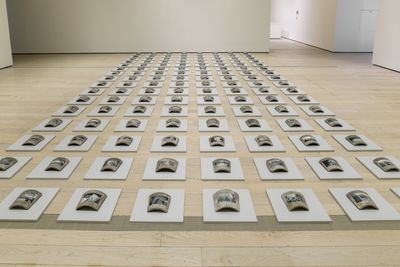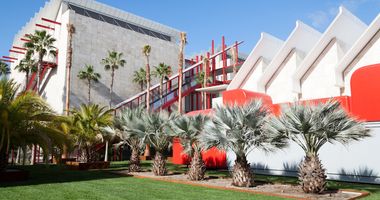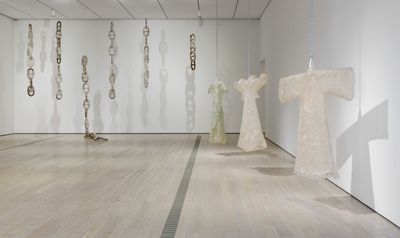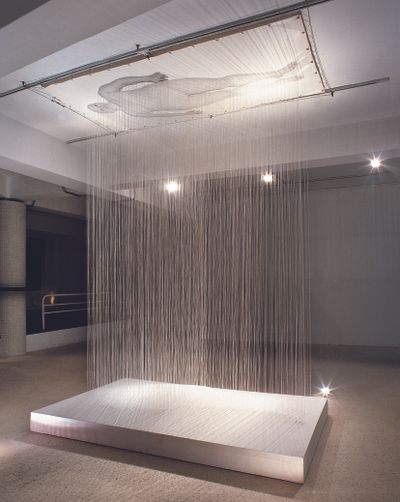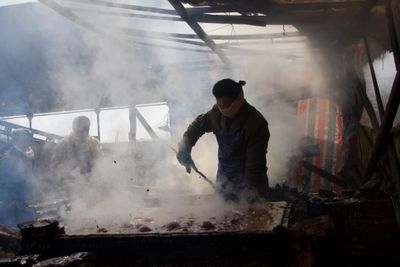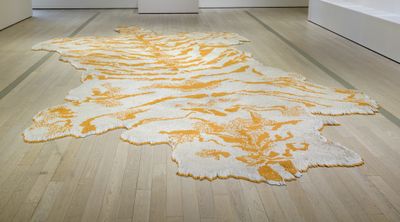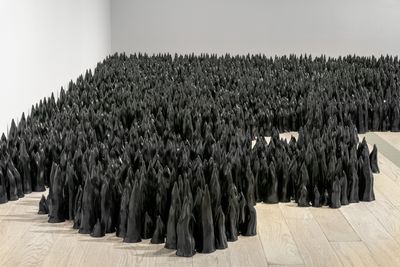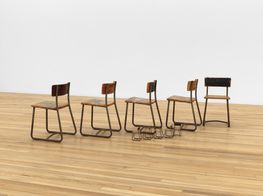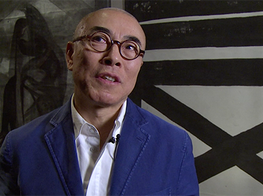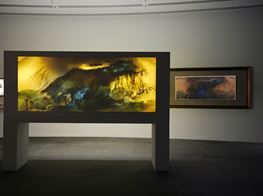LACMA Explores the Allure of Matter
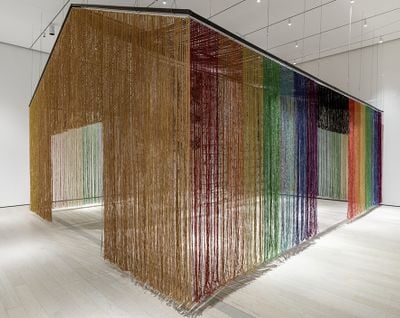
Gu Wenda, united nations: american code (2018–2019). Exhibition view: The Allure of Matter: Material Art from China, Los Angeles County Museum of Art (2 June 2019–5 January 2020). Photo: © Museum Associates/LACMA.
The Allure of Matter: Material Art from China at Los Angeles County Museum of Art (LACMA) (2 June 2019–5 January 2020) is an inter-generational show of 21 Chinese artists working from the 1980s to the present, including Ai Weiwei, Cai Guo-Qiang, Lin Tianmiao, Song Dong, He Xiangyu, Yin Xiuzhen, and Ma Qiusha.
Staged on Level 2 of LACMA's Renzo Piano-designed Broad Contemporary Art Museum building, the show unfolds within ten galleries. These include a connecting bridge where Zhan Wang's film of a stainless steel rock-like sculpture set adrift at sea, Beyond 12 Nautical Miles Floating Rock Drifts on the Open Sea (2000), is installed alongside a stainless steel replica of a boulder harvested from the Sierra Nevada Mountains, Gold Mountain (2007). Gold Mountain was inspired by the history of Chinese immigrants moving to San Francisco for the gold rush, and was created for an exhibition at the Asian Art Museum in San Francisco in 2008.
As a whole, The Allure of Matter has been organised by Wu Hung, professor of Chinese Art History at the University of Chicago and adjunct curator at the Smart Museum of Art, alongside Orianna Cacchione, Smart Museum of Art's first appointed curator of global contemporary art. The works on view at LACMA were co-curated by Stephen Little, LACMA's curator of Chinese art and head of the Chinese, Korean, and South and Southeast Asian art departments, with curatorial assistant of Chinese and Korean art, Susanna Ferrell.
As Wu Hung explains in his catalogue essay, the show 'coins the concept "Material Art," or caizhi yishu in Chinese, to define' a 'largely unexamined' yet 'crucial component' of contemporary Chinese art. The exhibition pays close attention to the 'consistent use of unconventional materials to produce works in which material, rather than image or style, is paramount in manifesting the artist's aesthetic judgement or social critique.'[1]
In an email interview, Wu Hung describes The Allure of Matter as 'a collaboration with many of the artists that began more than two decades ago,' which brings 'the twofold emphasis of the sensual and the conceptual.' Exemplary of this approach is a striking set of hanging metal chain sculptures by Liang Shaoji, located at one of the entrance galleries, titled Chains: The Unbearable Lightness of Being, Nature Series, No. 79 (2002–2007). A mediation between man-made and natural objects, Shaoji used living silkworms—which he views as collaborators and co-authors of the project—to make large-scale sculptures of rusty metal chains wrapped in shiny raw silk that the insects produced.
Next to Shaoji's work is Chinese Dream (2006), three floating reproductions modelled after different traditional robes by Wang Jin that have been refashioned industrially from PVC sheets and nylon thread, vastly speeding up a production process that typically involves the painstaking labour of skilled hand embroiders.
In the adjoining gallery, Lin Tianmiao presents Day-Dreamer (2000), an installation comprised of white thread extending from ceiling to floor. Filaments connect a black and white androgynous depiction of the artist on a sheet of white fabric installed on the ceiling, to a rectangular, fabric-covered plinth below. In making her body androgynous in the work, the artist toys with the destruction of the negative aspects of ascribing gender attributes to form, refusing to adhere to statically masculine or feminine characteristics.
One of the five female artists in the show, Day-Dreamer points to the way this exhibition deals with the gendered implications of material, and discussions on the legacies of female artists who use everyday (and particularly textile) materials to reference the domestic realm and its sociopolitical implications. An unresolved approach recalls the fluidity in scholar Jeehee Hong's elucidation of the 'ambivalent meanings in vernacular English' of the words material and materiality. As Hong explains, material can be defined as '"things that are material", which emphasises the physical aspect of things', though 'in various non-physical applications' material can mean 'something which can be worked up or elaborated, or of which anything is composed.'[2]
This interpretation of matter and its changeability applies to many artworks on view, which use both conventional and unconventional materials—including human hair, silk, gunpowder, and cigarettes—to express insightful perspectives on the objects and materials that circulate in daily life. He Xiangyu's A Barrel of Dregs of Coca-Cola (2009–2015), for instance, is a labour-intensive, alchemical sculpture consisting of a four-legged metal structure that supports a glass case containing a mound of tar-like matter—the result of the artist boiling litres of Coca-Cola for over six months until he was left with desiccated cola-ash resin.
Part of He Xiangyu's Cola Project (2008–2012), for which the artist also boiled down 127 tonnes of the soda, A Barrel of Dregs of Coca-Cola comments on the drink's vast global networks of consumption and production, along with the ability of matter to be transformed, changed, or dispersed without ceasing to exist.
Several monumental installations highlight these aspects of material through sculpture in expanded form—drawing attention to scale, surface, and material, while similarly bringing attention to the immaterial properties, and possibilities, of matter. Gu Wenda's united nations: american code (2018–2019) is an expression of unified cultures as a house made from rainbow-coloured braided human hair hanging from the ceiling, while Xu Bing's 1st Class (2011) is a visual and sensory floor-piece resembling a tiger-skin rug assembled out of over 500,000 1st Class brand cigarettes. 1st Class is a part of Xu Bing's 12-year Tabacco Project (1999–2011), a rigorous investigation into tobacco's local and global histories with a focus on the circulation of the American cigarette, and the industry's expansion into China in the late 19th century.
The conceptual framework of Xu Bing's project is expanded in the adjacent gallery, where most of the floor is taken over by Liu Jianhua's Black Flame (2016–2017), a sea of 8,000 individual pieces of black porcelain that look like flames twisting upwards. The work, writes Trevor Smith, represents a commentary on 'the social impact of excessive consumption and the cultural implications of export production aesthetics.'[3]
Similarly, while The Allure of Matter is a thoughtful survey that contemplates the ways artists engage with the ever-changing and at times messy and unstable properties of material, broader questions surrounding material circulation and consumption in the realm of art are also reflected in the exhibition as a form in itself.
The show is set to travel to five venues across the United States after the current showing at LACMA, including the Seattle Art Museum, the Peabody Essex Museum, and the Smart Museum of Art at The University of Chicago—a continuation of an ongoing trajectory of U.S. exhibitions surveying contemporary Chinese art, from Transience: Chinese Experimental Art at the End of the Twentieth Century at the Smart Museum of Art in Chicago (18 February–18 April 1999), to Art and China after 1989: Theater of the World, organised by the Solomon R. Guggenheim Museum in New York (6 October 2017–7 January 2018).—[O]
—
[1] Wu Hung, 'Material Art in China: An Introduction,' in Wu Hung and Orianna Cacchione; with Christine Mehring and Trevor Smith, The Allure of Matter: Material Art from China, exhibition catalogue, Chicago University Press, Chicago, Illinois: Smart Museum of Art (2019), p.15.
[2] JeeHee Hong, material, materiality, 'Theories of Media: Keywords Glossary,' The University of Chicago, online, https://csmt.uchicago.edu/glossary2004/material.htm
[3] Trevor Smith, 'Transformative Labors,' in Wu Hung and Orianna Cacchione; with Christine Mehring and Trevor Smith, The Allure of Matter: Material Art from China, exhibition catalogue, Chicago University Press, Chicago, Illinois: Smart Museum of Art (2019), p.70.

